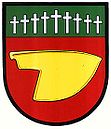Lesní Hluboké
| Lesní Hluboké | ||||
|---|---|---|---|---|
|
||||
| Basic data | ||||
| State : |
|
|||
| Region : | Jihomoravský kraj | |||
| District : | Brno-venkov | |||
| Area : | 496 ha | |||
| Geographic location : | 49 ° 16 ' N , 16 ° 18' E | |||
| Height: | 503 m nm | |||
| Residents : | 274 (Jan. 1, 2019) | |||
| Postal code : | 664 83 | |||
| License plate : | B. | |||
| traffic | ||||
| Street: | D1 : Prague - Brno | |||
| structure | ||||
| Status: | local community | |||
| Districts: | 1 | |||
| administration | ||||
| Mayor : | Karel Lupínek (as of 2009) | |||
| Address: | Lesní Hluboké 46 664 83 Domašov u Brna |
|||
| Municipality number: | 583294 | |||
| Website : | www.lesnihluboke.cz | |||
Lesní Hluboké (German Hluboky ) is a municipality in the Czech Republic . It is located seven kilometers southeast of Velká Bíteš and belongs to the Okres Brno-venkov .
geography
Lesní Hluboké is located in the Bobravská vrchovina on a knoll above the valleys of the Přibyslavický potok, Stříbrnický potok and Bílý potok . The village, completely surrounded by forests, lies on the edge of the Údolí Bílého Potoka Nature Park. The Zadní Hakna (491 m) rises to the north and the Prachová (530 m) to the south. To the south and west of Lesní Hluboké, the D1 / E 55 / E 65 motorway runs through the forest; the next exit 168 Devět křížů is 800 m west of the village. To the south is the Devět křížů motorway maintenance depot and police station.
Neighboring towns are Radoškov and Ve Žlebe in the north, Braníškov , Maršov and Lažánky in the Northeast, Javůrecký Mlyn, Maršovský Mlyn, Šmelcovna and Lažanský Mlyn in the east, Javůrek , Domašov and Rudka in the southeast, Zhořský Dvůr and Zálesná Zhoř in the south, Ludvíkov in the southwest, Devět Křížů and Košíkov in the west and Přibyslavice in the northwest.
history
In some writings, the first mention of Hluboky is dated to 1095. The secure first written mention of the place took place in 1395, when Wenceslaus IV confirmed all privileges of the Benedictine monastery Rajhrad in a document . In 1469 Matthias Corvinus conquered the area. He withdrew the monastery in retaliation for the fact that the Břevnov monastery on the side of his opponent George of Podebrady the goods. Together with Domašov and Ostrovačice , Hluboky became part of the city of Brno . In 1499 the monastery redeemed the pledge. Around 1600 the village consisted of 17 properties. In 1621 Johann Amos Comenius found refuge in the village for a short time. After the Thirty Years' War there are nine farms in Hluboky. Silver and iron ore were mined in the vicinity of Hluboky. In 1711 the Hluboky hammer was built on the Weißbach , probably in place of an older hammer mill. In 1838 186 people lived in the 25 houses in Hluboky.
After the abolition of patrimonial Hluboky formed a municipality in the Brno district from 1850. The hammer mill went out in the 1870s. In 1887 a one-class village school opened. In 1900 the place came to the district of Velké Meziříčí. Since 1923 the place was called Hluboké . It consisted of 41 houses and had 206 inhabitants. At that time there were 15 farms in the village. During the Second World War, General Vojtěch Boris Luža's partisan unit Havran acted in the counter . Between 1948 and 1960 the village belonged to the Okres Velká Bíteš. In the 1950s, the place name was expanded to distinguish it from the neighboring Hluboké by the prefix Lesní . In 1961, Lesní Hluboké came to the Okres Brno-venkov and was incorporated into Domašov at the same time . Instead of the Devět Křížů inn, a motel was built in 1968 . In 1972 the motorway from Prague via Brno to Bratislava was put into operation. At the end of the 1970s, the motorway maintenance depot was established. The municipality of Lesní Hluboké has existed again since 1990. In 1994 a major forest fire broke out between the castle and the motorway.
Community structure
No districts are designated for the municipality of Lesní Hluboké. The location Devět Křížů ( At the nine crosses ) belongs to Lesní Hluboké .
Attractions
- Baroque hunting lodge Lesní Hluboké, built in 1770
- neo-Romanesque chapel of St. Anna, built between 1776 and 1779 under Abbot Otmar Konrad
- Nine wooden crosses in Devět Křížů, in 1540 a trader who was transferred by his bride is said to have attacked the wedding party of his unfaithful people. When his accomplices also murdered the bride, the merchant shot his people and then judged himself. In addition to the bride, her two bridegrooms and the other six dead of the attack are said to have been buried on both sides. The nine crosses were last renewed from pine wood in 1985.
- Údolí Bílého Potoka Natural Park
Individual evidence
- ↑ Český statistický úřad - The population of the Czech municipalities as of January 1, 2019 (PDF; 7.4 MiB)

